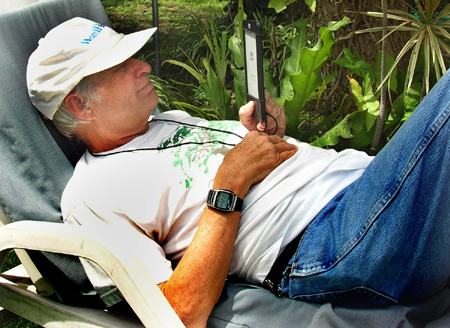By John Pint
 I
must confess that only a year ago, the very thought of reading a book
on a computer screen turned my stomach. If you feel the same way, read
on, because I eventually made some discoveries you might like. I
must confess that only a year ago, the very thought of reading a book
on a computer screen turned my stomach. If you feel the same way, read
on, because I eventually made some discoveries you might like.
Last
year my problem was that I had plumb run out of good books to read. I
had absolutely nothing and out of sheer desperation I decided to open a
program that had come preinstalled on my laptop: Nook for the PC,
designed to allow you to read books from Barnes and Noble and, of
course, buy them too.
Well, it didn’t take long to discover that I
could download the latest novel of two favorite authors, Preston and
Child, as an ebook for the same price as the paperback version. The
difference was that I would have the book “in hand” (well, on screen)
instantly and pay no overseas shipping charges whatsoever. So I did it
and could not get over the fact that –ten seconds after paying with my
credit card—my book had arrived and I could start reading it.
What’s
it like to read a book on a laptop? Well, one important feature is that
you can set the type size and the shape of the window to whatever you
want. You can also highlight any word and a dictionary definition will
pop right up. But there were some disadvantages: to me, reading on the
computer screen seemed tiring on the eyes; flipping pages for quick
skimming was virtually impossible and God help you if you fell asleep
and the laptop slid off your chest.
Nevertheless, I kept
using my
laptop as a reader, simply because thousands of ebooks are now
available, many of them free of cost either because they are classics
or because their authors are novices. Also, a lot of public libraries
north of the border now lend their members ebooks via internet.
By
now I was being bothered by another problem with laptops: you can’t use
them in the sunshine. So I started investigating ebook reading devices
like the Kindle, which Amazon pioneered. These are thin, flat and
lightweight, with batteries that may allow you to read for a week
without recharging. Most importantly for me, I discovered that many
such readers have an “E-Ink” screen which has characteristics much like
paper: it doesn’t bother your eyes and it’s perfectly readable in the
brightest sunlight. The original Kindle now sells for $79 at Amazon but
there are even cheaper competitors and I ended up buying a Kobo (an
anagram for…guess what?). My Kobo is thin, amazingly lightweight and
easy to read outdoors. The first thing I did was tie an elastic cord to
it, with a loop which I can put around my neck for reading when lying
down.
I also discovered that I
can download to my device the
electronic version of all kinds of magazines and newspapers, which I
couldn’t possibly subscribe to in Mexico due to the high cost of
postage, without mentioning the strange way such publications can
vanish into thin air this side of the border. However, reading a
magazine or newspaper on my Kobo is a bit weird. The original formats
are discarded and headlines or titles are listed in a menu. Due to lack
of space, many of the titles are abbreviated. For example, one read:
“What we could lose if the James…”
Well, who could ever
guess what
THAT article was about? In fact, I discovered the full title was “What
we could lose if the James Webb telescope is killed” and it turned out
to be a subject I was, indeed, very interested in. I should
also
add that in these e-versions of magazines and papers, all the pictures
are shrunk to a tiny size. Nevertheless, they are better than having
nothing at all.
One other discovery
needs mentioning: a marvelous
computer program called Calibre.
It’s completely free (a labor of love
by its inventor, Kovid Goyal), easy to use and it can transform ebooks
from one format to another and then download them into your Kindle,
Nook, Kobo or whatever.
If I lived in an
English-speaking country,
I’d probably stick to books made of paper, but because I’m in Mexico, I
am delighted with the instant availability of ebooks, combined with the
practical aspects of an ereader. If you are an ex-pat and like to read,
this is something worth investigating.
|

